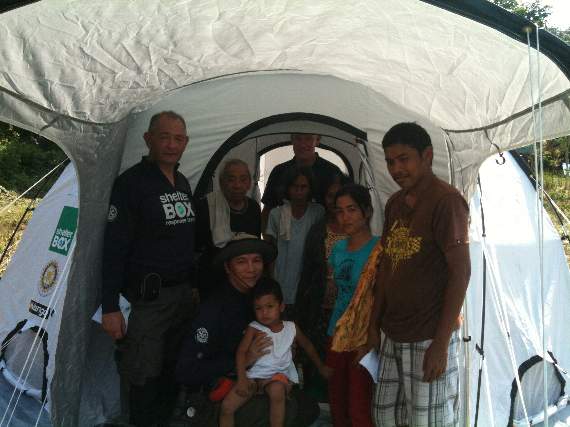WHEN Tim Vile retired from the fire service in 2012, little did he know that just two years later he would be travelling to the treacherous borders of war-torn Syria to set up a vital life line for refugees fleeing persecution by the Assad regime.
As a volunteer for the disaster relief charity ShelterBox, Tim, 59, has over the last three years witnessed at first hand the impacts of humanitarian disasters in the Middle East, Asia and Europe, delivering vital survival tools to those in the most desperate need.
A member of the Rotary Club of Farnborough, Tim first became involved in ShelterBox through Rotary International’s long-standing support of the charity, founded by members of the Rotary Club of Helston-Lizard, Cornwall in 2000.
And in 2012, shortly after leaving Hampshire Fire and Rescue, the Rotarian took his involvement in the charity up a notch - applying for a job as a ShelterBox response team member.
Tim underwent a rigorous assessment and training process in Cornwall and, out of the thousands of people to apply, was one of just a handful selected to deliver ShelterBoxes on the front lines of the charity’s relief efforts.
He was sent on his first deployment just months later, travelling to the Philippines to help those affected by the 2013 earthquake, and returned to the country later that same year after the south-east Asian country was again hit by Typhoon Yolanda.
Last year, Tim also took part in ShelterBox’s first ever deployment in Europe, helping victims of the 2014 floods in Bosnia.
However, perhaps his most challenging task to date has been establishing supply routes into Syria from its land borders with Turkey, Jordan and Lebanon - against a backdrop of civil war, the so-called Islamic State uprising and ever-present threat of kidnappings.
Speaking to members of the Rotary Club of Farnham in October, Tim said: “I first went to the Middle East in 2014 when, at the request of the Jordanian Army, we set up a camp just inside the border with Syria.
“People were getting bombed and strafed in the fields by the Syrian Army as they came over the border and even at night they were still getting attacked. The situation’s moved on a bit since then and now of course there’s a third party, so it’s probably even worse.
“ISIS were active in the area when we were out there, but it was to a much lesser degree at that stage. There were security issues, but it was really just about getting our emergency supplies to the refugees.
“These are people just like you and I - not just villagers but people with families and many are professionals. They’ve all got lives and now they’re living in the mud and being bombed every day. The Syrian regime has left them with absolutely nothing. That’s what’s driving us on.”
As well as setting up the camp on the Jordanian border, while in the Middle East, Tim also travelled to the Turkish border to set up a network to allow ShelterBox to distribute its boxes inside Syria itself.
Beyond the usual distribution difficulties, working in such close proximity to a region where ISIS has been known to target humanitarian workers and journalists for kidnappings presented its own dangers and challenges.
“Of course you have to be respectful of the threat of kidnappings, but that’s where a lot of the training and your personal qualities come in,” said Tim.
“You’ve got to know where to draw the line and not be bullish and say well let’s do it anyway. We’re not deployed anywhere where there is a direct threat to us, and although the nature of the job means you are often working in dangerous places, you have to apply sensible precautions.
“As an organisation we cannot be present over the Syrian border because quite simply we may never come back. So the important thing for us in the Middle East was to find partner agencies who we trust to make the right decisions about who to give our humanitarian aid to.
“Since 2014 we’ve worked hand in hand with a group called Help in Hand for Syria, which is locally led by a British Syrian guy and that agreement is still ongoing.”
Tim’s ability to work in difficult circumstances and under intense pressure was hardened during his 35-year career in the fire service. But even he admits that little could prepare him for the scene of mass destruction witnessed on his first deployments with ShelterBox in the Philippines.
Unlike the disaster in Syria, caused predominantly by political unrest over a number of years, the magnitude 7.2 earthquake in October 2013 followed by one of the strongest tropical cyclones ever recorded in the Philippines just a month later left many thousands of people dead and millions homeless in a matter of weeks.
Tim continued: “When I flew into the island of Leyte after the typhoon it was like flying over the south of England but everything was destroyed. It was incredible and I’ve never seen devastation on that scale ever.
“We see it on our televisions, but to actually see it for real and then get on the ground and everywhere you go people have lost members of their family is staggering. They are literally just lost, they don’t know where they are because everything has been reduced to rubble.
“I spoke to an English guy who was living over there with a Philippine family, and he said they were hunkering down for the storm and knew it was coming, but didn’t appreciate what was going to happen. The winds hit them and within minutes they were swimming for their lives, still trapped inside their house. They were a mile inland.
“I wouldn’t say it affects me as my background with the fire service has muted that a little bit, but it certainly has an effect on you and it gives you tremendous empathy for these people.”
ShelterBox response teams are usually made up of just two un-paid volunteers like Tim, often strangers from opposite corners of the globe. For this reason, one of the key requirements the charity demands of its volunteers are excellent people skills.
Once a new humanitarian disaster becomes apparent, the response teams swing into action, often flying to the disaster zone within 48 hours to assess the number of people affected and arrange for the distribution of ShelterBoxes to those most in need - focusing on the elderly, disabled and those with young children.
Each ShelterBox is tailored to the nature and location of the disaster, but typically contains a tent designed to withstand extreme weather conditions, a water purification kit from Farnham-based company Pure Hydration, blankets, tools, and other necessities to help a family survive after a disaster.
The response teams usually spend around two to three weeks in the disaster zone co-ordinating the relief efforts alongside other agencies such as the Red Cross, typically working from first light until late in the evening.
For more information about ShelterBox, volunteering opportunities and how to support its relief efforts, visit the website www.shelterbox.org.




Comments
This article has no comments yet. Be the first to leave a comment.